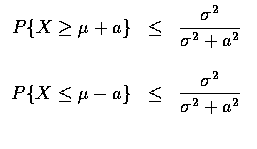If X is a random variable with mean 0 and finite variance
Other Inequalities
Proposition (One-Sided Chebyshev Inequality)
If X is a random variable with mean 0 and finite variance ![]() ,
then
for any a>0
,
then
for any a>0


![$P\{X\geq a\}\leq\displaystyle\frac{E[X+b)^2]}{(a+b)^2}=\frac{\sigma^2+b^2}{(a+b)^2}$](img7.gif)
Suppose now that X has mean ![]() and variance
and variance ![]() .
As both
.
As both ![]() and
and ![]() have mean 0 and variance
have mean 0 and variance ![]() ,
we obtain, from the one-sided
Chebyshev inequality, that for a>0,
,
we obtain, from the one-sided
Chebyshev inequality, that for a>0,


Corollary
If ![]() ,
,
![]() ,
then for a>0,
,
then for a>0,

When the moment generating function of the random variable X is known, we can
obtain even more effective bounds on
![]() .
Let
M(t)=E[etX] be
the moment generating function of the random variable X. Then for t>0,
.
Let
M(t)=E[etX] be
the moment generating function of the random variable X. Then for t>0,
![$\begin{array}{rcl}
P\{X\leq a\}&=&P\{e^{tX}\geq e^{ta}\} \\ \\
&\leq&E[e^{tX}]e^{-ta}
\end{array}$](img20.gif)
Proposition (Chernoff Bounds)
Definition
A twice-differentiable real-valued function f(x) is said to be convex if
![]() for all x; similarly, it is said to be concave if
for all x; similarly, it is said to be concave if
![]()
Some examples of convex functions are f(x)=x2,
f(x)=eax,
f(x)=-x1/nfor ![]() .
If f(x) is convex, then
g(x)=-f(x) is concave, and vice
versa.
.
If f(x) is convex, then
g(x)=-f(x) is concave, and vice
versa.
Proposition (Jensen's Inequality)
If f(x) is a convex function, then
